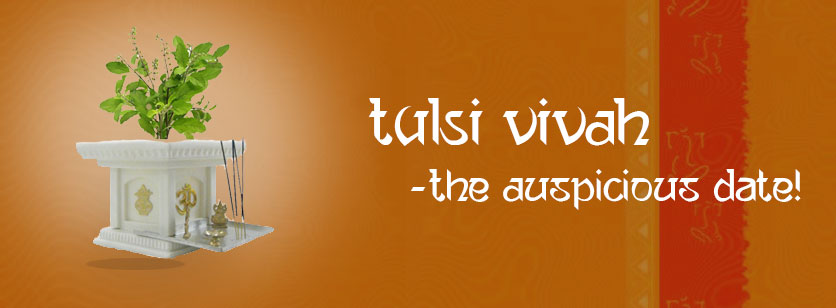
‘Tulsi’, also known as the Indian basil, is often referred to as the ‘matchless’ herb because of its abundant qualities. As per Hindu mythology, Tulsi has been given many different names. For instance: ‘Vaishanavi’ (the one that belongs to Lord Vishu), Vishnu Vallabha[the one precious to Lord Vishnu], Haripriya and Vishnu Tulsi (beloved to Lord Vishnu). Available in various varieties, our country (India) is blessed with varieties
- ‘Rama Tulsi’ or ‘Shri Tulsi’ with bright green leaves (Shri = Lakshmi; the wife of Lord Vishnu; and Rama = an avatar of Vishnu).
- ‘Shyama tulsi’ or ‘Krishna Tulsi’ has dark green or purplish leaves (Krishna = an avatar of Lord Vishnu; and Shyama = dark complexion of Krishna).
Tree worship is a very common tradition in Hindu religion, and Tulsi or Ocimum tenuiflorum is considered to be the most sacred of all the plants. It is marked as an entry point between the heaven and the earth and due to this reason, Tulsi holds an important place in every Hindu house. Hindus build a special structure at the entrance of their houses, which has an idol of Goddess embossed on all four sides of the structure called Tulsi Vrindavana. Worshiping Tulsi by lighting a diya is a part of everyday routine. It is believed that whosoever waters and cares of Tulsi, gains blessings of Almighty Vishnu and acquires Moksha.
When is Tulsi Vivah Celebrated?
Tulsi vivah is marked as a ceremonial wedding of Tulsi plant (Tulsi Mata) with Lord Vishnu (Shaaligram). Falling on 12th November this year, this auspicious day starts from Ekadashi (11th day of bright fortnight) of Kartik month and stays till full moon (Kartik Poornima) or in other words, it beings from Kartik Ekadasi to Kartik Poornima.
The legendary story of Tulsi Vivah
As per Padam Puran, Tulsi was once a woman named Vrinda, who got married to an evil king, Jalandhar. Vrinda worshipped Lord Vishnu day and night with utmost devotion, in order to make her husband invincible. As a result, Jalandhar became very powerful and no God could defeat him. One day, Lord Vishnu converted himself as Jalandhar and offended Vrinda which led to the destruction of her integrity, and in the mean while, Jalandhar was killed by Lord Shiva. Later, when Vrinda realized the truth, she doomed Lord Vishnu into black color and cursed him a separation from his wife. Subsequently this was fulfilled, when Vishnu was transfigured into the Shaaligram (the black stone) and in his Rama avatar, he had to bear solitude from his wife Sita, who was kidnapped by Ravana. Vrinda burnt herself along in her husband’s pyre. Later, Lord Vishnu transformed her soul into Tulsi plant and gave her the boon of becoming her husband in the next birth. This gave rise to the tradition of marrying Tulsi with Shaaligram on every Prabodhini.
It is believed that on the eve of Tulsi Vivah, Goddess Lakshmi (in the form of Tulsi) and Lord Vishnu (in the form of Shaaligram) are worshipped & married, which invites positive vibes from the universe. It further reduces the negative vibes and any auspicious work (shubh karya) such as hindu weddings, house warming ceremony, etc can be performed on the eve of Tulsi vivah.
The wedding ceremony of Tulsi with Vishnu (Shaaligram) is very similar to that of Hindu wedding. The daughterless parents bear the expenses of this Tulsi vivah and complete the ceremony by offering Tulsi as their daughter to Lord Vishnu.
Marriage Ceremony
A mandap (temporary platform) is constructed at the place where Tulsi is planted. The ladies of the house observe the fast till evening. The Tulsi is draped with a red cloth (sari) and is decorated with the various ornaments such as bangles, etc. The bridegroom is a brass portrait of either Lord Vishnu or Krishna, or mostly Shaaligram, and is covered with dhoti (an Indian dress for men). The Shaaligram and Tulsi are given bath and are garlanded with flower garlands. Tulsi and Shaaligram are then tied together with a thread (mala) and the priest recites the wedding mantras (mangal ashtaka). Mixture of raw rice with vermilion is showered on the couple. Lord Vishnu is presented with sandal wood mixture, male clothes and janneu (sacred thread)] while Tulsi, the bride, is presented with sari, turmeric and Mangal Sutra (Hindu wedding necklace). After the ceremony, all these offerings are given to the Brahmin priest. Sugar canes, peanuts, coconut chips and fruits are given to the guests as Prasadam. It is said that the soul of Goddess Lakshmi and Lord Vishnu dwells in Tulsi plant after dusk and goes away in the morning.
The celebration of Tulsi vivah varies from place to place. It marks the onset of the Hindu wedding season and is the most auspicious and pious date in Hindu Calendar.
 +91 9990176000
+91 9990176000 +91 9999097600
+91 9999097600
 CALENDAR 2024
CALENDAR 2024










